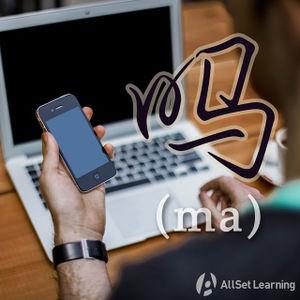Difference between revisions of "Yes-no questions with "ma""
| Line 91: | Line 91: | ||
</div> | </div> | ||
| − | This is OK because the original sentence "你知道这是什么东西"(Nǐ zhīdao zhè shì shénme dōngxi) is a statement even though it contains the question word 什么. It's the same in English. "You know ''what'' this is" can be converted into the question "''Do'' you know ''what'' this is?" | + | This is OK because the original sentence "你知道这是什么东西"(Nǐ zhīdao zhè shì shénme dōngxi) is a statement even though it contains the question word 什么 (shénme). It's the same in English. "You know ''what'' this is" can be converted into the question "''Do'' you know ''what'' this is?" |
Here are more examples: | Here are more examples: | ||
Revision as of 02:45, 15 October 2014
-
Level
-
Similar to
-
Used for
-
Keywords
The question particle 吗 (ma) is a very simple way to form questions in Chinese. By placing 吗 (ma) on the end of a statement, you convert it into a "yes/no question," (questions that could be answered with yes or no in English.) They're also known as "polar questions."
Contents
Basic Usage
Structure
Any statement can be converted into a yes / no question with 吗 (ma). You could think of 吗 (ma) as being like a question mark you say out loud. So the basic structure is :
statement sentence + 吗 ?
For example:
- 你 喜欢 咖啡。 (statement) You like coffee.
"You like coffee" can easily be converted into "Do you like coffee?" by adding 吗:
- 你 喜欢 咖啡 吗? (question) Do you like coffee?
Examples
More examples of statements and their yes/no question forms:
- 你 是 医生。 (statement) You are a doctor.
- 你 是 医生 吗? (question) Are you a doctor?
- 那 是 老虎。 (statement) That is a tiger.
- 那 是 老虎 吗? (question) Is that a tiger?
- 他 是 老师。 (statement) He is a teacher.
- 他 是 老师 吗? (question) Is he a teacher?
- 你 是 学生。 (statement) You are a student.
- 你 是 学生 吗? (question) Are you a student?
- 你 喝 茶。 (statement) You drink tea.
- 你 喝 茶 吗? (question) Do you drink tea?
- 你 去。 (statement) You go.
- 你 去 吗? (question) Are you going?
- 你 学 中文 (statement) You study Chinese.
- 你 学 中文 吗? (question) Do you study Chinese?
- 你 认识 我 (statement) You know me.
- 你 认识 我 吗? (question) Do you know me?
- 你 会 做 饭 (statement) You make food (dinner).
- 你 会 做 饭 吗? (question) Are you making food (dinner)?
- 你 想 家 (statement) You miss home.
- 你 想 家 吗? (question) Do you miss home?
It's important to remember that you can not add 吗 (ma) to a sentence that's already a question. For example:
- 你 是 谁 吗?(谁 is a question word) Are you who?
- 这 是 不 是 书 吗?(是不是 is a question pattern) Is this a book, is?
These would be something like "Do you who are you?" and "Does is this a book?" in English - obviously wrong. Still if you're not careful, you may find yourself throwing a 吗 (ma) onto the end of a question that doesn't need it. Many learners make this mistake, so don't worry if it happens every once in a while, just catch it and remember it the next time.
More Advanced Usage
However, this doesn't mean that a sentence can't ever have a question word and 吗 (ma). If a sentence contains verbs of understanding such as "知道 (zhīdao),了解 (liǎojié), 明白 (míngbai), 认识 (rènshi)" etc, then "吗" (ma) can still be added at the end of the question. For example:
- 你 知道 这 是 什么 东西 吗?Do you know what this thing is?
This is OK because the original sentence "你知道这是什么东西"(Nǐ zhīdao zhè shì shénme dōngxi) is a statement even though it contains the question word 什么 (shénme). It's the same in English. "You know what this is" can be converted into the question "Do you know what this is?"
Here are more examples:
- 你 明白 这 是 什么 意思 吗?Do you understand the meaning of this?
- 你 明白 这 个 句子 的 意思 吗?Do you understand the meaning of this sentence?
- 你 明白 他 的 问题 是 什么 吗?Do you understand what his question is?
- 你 知道 他 是 谁 吗?Do you know who he is?
- 你 知道 怎么 学 中文 吗?Do you know how to learn Chinese?
- 你 知道 他 叫 什么 名字 吗?Do you what his name is?
- 你 知道 怎么 用 QQ 吗?Do you know how to use QQ?
- 你 知道 王 老师 是 哪里 人 吗?Do you know where Mr. Wang (teacher) is from?
- 你 了解 中国 人 喜欢 什么 吗?Do you understand what Chinese people like?
- 你 了解 他 的 想法 吗?Do you understand his ideas?
See also
Sources and further reading
Videos
- Yoyo Chinese: Yes-no Questions with 吗
Books
- Chinese: An Essential Grammar, Second Edition (pp. 138-40) →buy
- Integrated Chinese: Level 1, Part 1 (3rd ed) (pp. 29-30) →buy
- New Practical Chinese Reader 1 (新实用汉语课本1) (p. 21) →buy
- New Practical Chinese Reader 1 (新实用汉语课本1)(2nd ed) (pp. 23, 250) →buy



